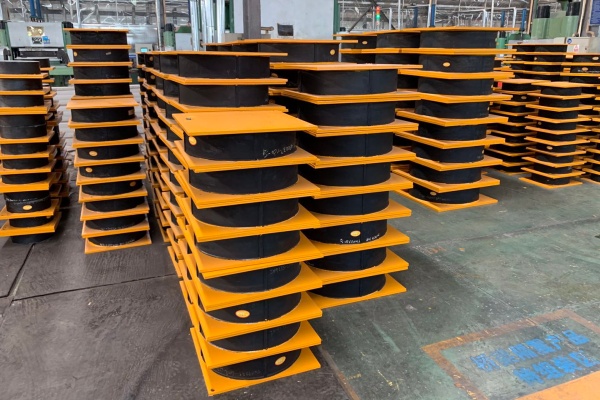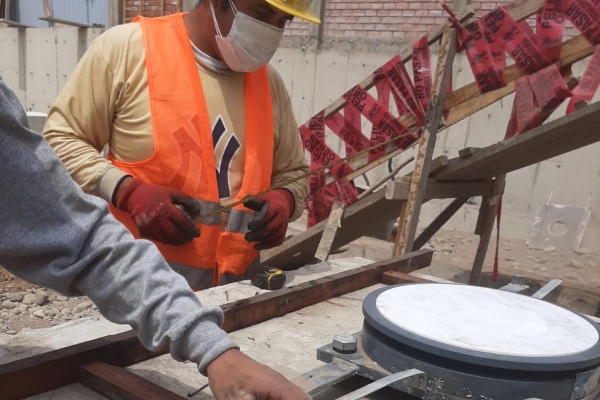China's Bridge Bearing Technology: From Reliable Joints to Intelligent Cores
At the construction site of the Changtai Yangtze River Bridge, a spherical steel bearing weighing 120 tons was precisely installed. This seemingly simple "steel joint" can support a staggering 190,000 tons—equivalent to bearing the weight of four Bird's Nest stadiums simultaneously.
Over the past 15 years, China's bridge construction has witnessed unprecedented growth, creating numerous world-record-holding marvels. The number of highway bridges surged from 805,300 in 2016 to 961,100 in 2021, with an average annual increase of 31,200 structures. This massive scale of development demanded corresponding advancements in critical components, particularly bridge bearings—the crucial connecting "joints" between superstructure and substructure.
China's bridge bearing technology has achieved a qualitative leap, progressing through three key developmental stages:
The Materials Revolution redefined performance boundaries. The application of high-performance polymer composites reduced the friction coefficient of bearings to below 0.03, surpassing the international standard of 0.05. The Ultra-High-Performance Sliding Material developed by Zhejiang Communications Group increased wear resistance by 12 times, achieving complete material independence.
Structural Innovation addressed the specific needs of mega-bridges. For cross-sea bridges facing dual challenges of typhoons and salt corrosion, developed Corrosion-Resistant Spherical Bearings utilize full stainless-steel cladding, creating a permanent "anti-corrosion armor." The 3D Seismic Isolation Bearings developed by some enterprises can simultaneously dissipate both vertical and horizontal seismic energy, a technology considered internationally leading.
Intelligent Monitoring transformed bearings into bridge health "diagnosticians." The latest generation of Intelligent Bearings incorporates fiber optic sensing systems, monitoring 12 parameters like pressure, displacement, and temperature in real-time. Data is transmitted via IoT to monitoring centers, upgrading their function from "passive support" to "active monitoring."
A particularly significant area of advancement lies in Seismic Isolation Bearings. Chinese technology in this specialized field has progressed remarkably, offering enhanced protection for bridges in seismically active regions.
Lead-Rubber Bearings (LRBs) have seen substantial improvements. The latest Chinese designs incorporate high-damping rubber compounds with a damping ratio exceeding 18%, significantly outperforming many conventional international products. The lead core purity has been increased to 99.99%, ensuring stable hysteretic behavior and consistent energy dissipation through countless cycles.
Friction Pendulum Bearings (FPBs) represent another frontier. Chinese engineers have developed multi-stage FPB systems with dual spherical surfaces. These allow for different friction coefficients and periods at varying displacement stages, effectively managing a wider range of seismic events from minor tremors to major earthquakes. The articulated slider is often made from proprietary composite materials with ultra-low wear rates.
Hybrid Seismic Systems combine different isolation technologies. For instance, some Chinese bridges now use a system where Elastomeric Bearings work in concert with shock transmission units. This combination controls displacement under service loads while providing robust energy dissipation during a seismic event, offering a balanced solution for both safety and serviceability.
These specialized seismic isolation bearings undergo rigorous prototype testing, often exceeding 5 million load cycles to validate their long-term performance and durability under repeated seismic loading.

In the field of bridge bearings, differing technical philosophies exist, with China now achieving leadership in several aspects:
Regarding Design Philosophy, while Europe and America emphasize theoretical safety margins, China prioritizes practical engineering applicability and ultimate performance. For example, Chinese-developed Large Displacement Spherical Bearings offer 25% greater displacement capacity than European equivalents while maintaining the same load capacity, making them better suited to China's complex geological conditions.
In Testing Standards, where Japan mandates bearing fatigue tests of at least 5 million cycles, China's new regulations have increased this to 8 million cycles, adding extreme environment simulation tests. The Seven-Dimension Testing System established in Jiangsu covers a temperature range from -40°C to 80°C, with standards exceeding common international requirements.
Concerning Service Life, while German standards require a 50-year design life for bearings, China's domestically developed Century-Service-Life Bearings have demonstrated a 120-year lifespan through accelerated aging tests, a technology already deployed in key projects like the Hangzhou-Ningbo Expressway.
The maturity of Chinese bridge bearing technology has been proven in a series of mega-projects:
The Hong Kong-Zhuhai-Macau Bridge utilizes over 2,400 custom bearings, some installed at depths of -45 meters. These bearings successfully withstood the test of Typhoon Mangkhut (Category 5), with displacement data fully meeting design predictions, proving the reliability of domestic bearings in extreme marine environments.
The Changtai Yangtze River Bridge bearing system set multiple records: maximum vertical load capacity of 190,000 kN and displacement capacity of ±800 mm, placing it at the world's leading level. Its unique multi-level protection system ensures safety for a century in the busy waters of the Yangtze River.
The Beipanjiang First Bridge, as the world's highest bridge, required bearings that addressed the unique challenge of a 565-meter vertical drop. The specially developed Wind-Resistant Bearings effectively suppressed vortex-induced vibrations caused by strong canyon winds, ensuring high-speed traffic safety.
Chinese bridge bearing technology is evolving along two primary trajectories:
Intelligent Upgrades are entering a new phase. Next-generation intelligent bearings will integrate Micro-Electro-Mechanical Systems (MEMS), enabling real-time 3D visualization of stress states. Concurrently, AI-powered predictive maintenance systems are under development, using big data analytics to forecast potential bearing failures up to 30 days in advance.
Longevity Technology is achieving new breakthroughs. The Nano Self-Healing Materials developed by research institutes can automatically repair micro-cracks within the bearing, extending service life by 25%. Innovations in surface treatment technology have increased the anti-corrosion service life of bearings from 50 years to 100 years.
Standardization System Development is progressing simultaneously. The new "High-Performance Highway Bridge Bearings" standard, expected around 2025, will for the first time incorporate a Full Lifecycle Assessment framework, pushing the industry from "manufacturing" towards "intelligent manufacturing."
From cross-sea bridges in the East China Sea to canyon bridges in the west, from the icy north to the high-temperature, high-humidity environment of the South China Sea, China's independently innovated bridge bearings—spherical bearings, seismic isolation bearings, pot rubber bearings, wind-resistant bearings, intelligent bearings—now silently support the nation's economic arteries. These seemingly simple components have become a powerful symbol of China's infrastructure strength and technological prowess.
